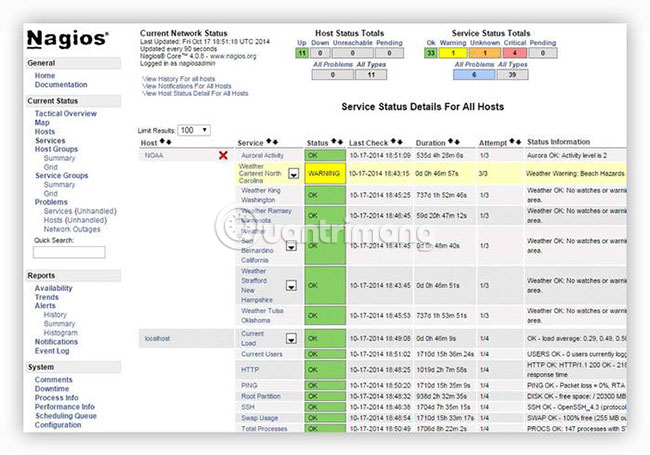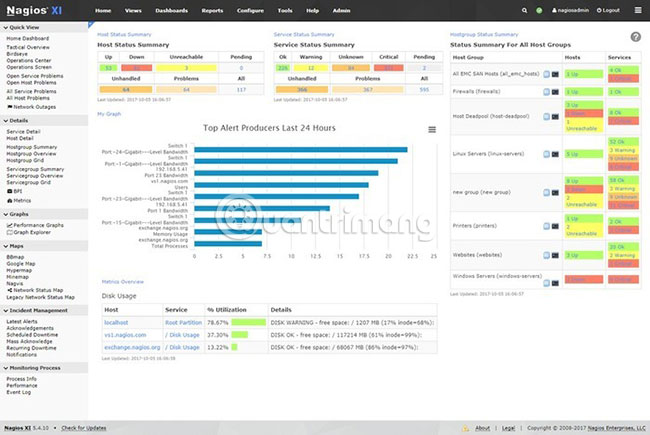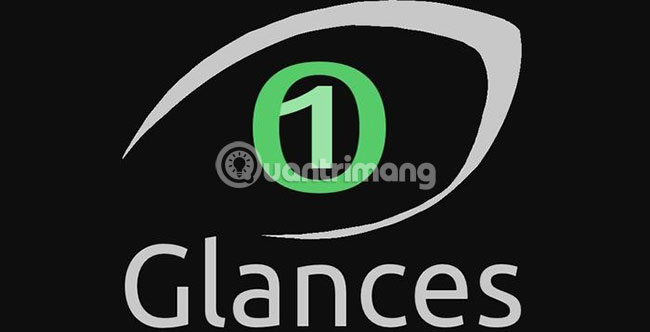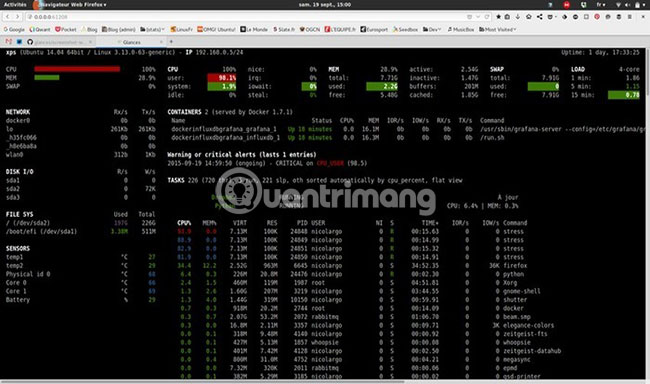3 best system monitoring tools for Ubuntu
As the number of devices, servers, and services in your business or organization increases, that's when systems must be monitored. Monitoring the system, in place or in the cloud, includes capabilities, operations, as well as server and application health. This process is designed to include all computing resources to find and solve problems in real time, before they happen.
If you are using Ubuntu, system monitoring tools will help detect any corrupted errors or services before they affect users.
The most basic tool is System Monitor, a built-in utility for Linux, which acts as the Windows Task Manager, and provides basic activity monitoring information for running processes and even cost-effective factors. most resources.
However, there are sophisticated system monitoring tools that show more resource usage information for memory, CPU, disk and network connectivity.
Here are the top 3 system monitoring tools that can be used with Ubuntu.
Learn about Nagios, Glances and Htop - 3 Ubuntu system monitoring tools
- 1. Site24x7's monitoring platform
- 2. Nagios
- Nagios Core
- Nagios XI
- 3. Glances
1. Site24x7's monitoring platform
With Site24x7's monitoring platform, you can eliminate Linux server outages and performance issues by constantly tracking over 60 key performance metrics, including the load average, CPU, memory, disk space, network bandwidth utilization, recent events, and Linux processes.
Configure thresholds for key performance metrics and receive instant alerts via SMS, emails, mobile app push notifications, and other ITSM and collaboration tools whenever these thresholds are breached.

Site24x7 lets you automate incident remediation and makes your IT operations more agile and efficient.
Key features:
- Better visibility into the processes that affect your server health and performance with the exclusive Top Process Chart
- Services monitoring and syslog monitoring for Linux servers
- A single console for MSPs to monitor their customers' IT infrastructures
- Monitored metrics pushed via StatsD
- Support for over 100 plugins, including Redis, MySQL, and NGINX
2. Nagios

This system monitoring tool for Ubuntu provides complete monitoring of servers and workstations - including service status and processes, operating system metrics, file system usage, etc.
Nagios is a powerful, reliable, expandable and customizable software (although the configuration is complex). As a standard that has existed for a long time in the field of network and system monitoring, Nagios has great benefits such as fast detection of protocol errors and loss of life, plus an increase in services and machines. master and application.
Two solutions available for system monitoring are Nagios Core and Nagios XI.
Nagios Core

This is the free open source version that monitors servers, applications and services. Nagios Core comes with features like a basic user interface with network maps, SMS reports, email and basic reports.
Nagios Core monitors critical IT infrastructure components, from system, server, application, service and network data metrics. After that, Nagios Core sends notifications via SMS, email or custom script when important components fail and recover, so administrators are always informed about important events.
Available reports provide a historical record of events, deactivation, notifications and alert responses for future review, plus advanced charts to plan upgrades before Obsolete systems are at risk of malfunction.
This is a powerful open source option for monitoring Ubuntu systems, with great features like web interface, multi-tenant capabilities (a single version of the software application that serves many customers). and structure, expandable through integration with internal or third-party applications and community-developed add-ons.
It will take some time to learn when you start, but an active community is always ready to help if you need assistance.
Nagios XI

This is a commercial variant of the Nagios tool, which has a richer feature range and supports automatic configuration.
Nagios XI's powerful features (more than Core offers) include the powerful Nagios Core 4 monitoring tool, which provides the highest level of server performance monitoring. Nagios XI also includes configuration guides to guide users through monitoring devices, services and applications, taking snapshots to save recent configurations and reverting to the old configuration if desired.
You can customize the design, layout and options according to each user by using the updated GUI, so customers and collaborators get the flexibility they want. Nagios XI also features a custom role assignment to ensure a safe environment.
Advantages of Nagios:
- Easy to use
- Provide free and paid options (with a 60-day trial version)
- Comprehensive IT infrastructure monitoring, since all critical infrastructure components are monitored
- Allows multiple users to access the web interface and see the related infrastructure status
- Quick configuration with just a few simple clicks
- Easy to set up and manage user accounts
- Extensive structure using add-ons
3. Glances

This is a multi-platform data center monitoring tool, running on GNU / Linux, macOS, Windows and BSD operating systems. Glances are written in Python, using the psutil library to retrieve information from the system, providing users with lots of content at a glance.
You can use Glance to monitor load averages, CPU, memory, I / O drives, network interfaces, connected devices, using file system space, etc.
One of the key features of Glance is the ability to set thresholds in configuration files with 4 options, displayed in different colors: OK (green), Careful (blue), Warning (purple) and Critical (red).
Thresholds are set at 50, 70 and 90, corresponding to Careful, Warning and Critical. You can customize these files using the file 'glances.conf' found in the '/ etc / glances /' directory.

See important information such as average CPU load, disk I / O read / write speed, current disk usage for attached devices and top processes along with CPU / memory usage. of them.
The downside of having all this information is that Glances tends to use a significant amount of CPU resources.
If you need help with Glances, use the wikis available on the site. You can also contact other developers and users on Twitter, chat features for developers and user groups.
Advantages of Glances:
- Easy to install because it is available on the Ubuntu repository
- Show more information than other monitoring tools
- Web-based GUI for flexible monitoring
- Can monitor the system remotely
What system monitoring tool do you use for Ubuntu? Leave comments in the comment section below!
You should read it
- 6 leading Exchange Server monitoring software
- 8 best storage management and monitoring software
- 10 best IP monitoring tools
- 5 best IT infrastructure monitoring tools
- How to use Raspberry Pi to monitor network with Nagios
- How to automate system monitoring with Python
- 5 useful network monitoring tools
- The best applications to monitor system performance on Android
May be interested
- Learn about Microsoft Network Monitor tool - part 1
 if you are constantly exposed and working with the windows operating system, you will certainly feel that microsoft network monitor is one of the tools to support the analysis and management of the best network system today with many function...
if you are constantly exposed and working with the windows operating system, you will certainly feel that microsoft network monitor is one of the tools to support the analysis and management of the best network system today with many function... - Ubuntu 21.04 users need to update the system ASAP
 according to the proposed roadmap, it is only a few days before canonical will officially stop providing updates for ubuntu 21.04 'hirsute hippo', which has been available since april last year.
according to the proposed roadmap, it is only a few days before canonical will officially stop providing updates for ubuntu 21.04 'hirsute hippo', which has been available since april last year. - Instructions for installing Ubuntu on VMware Workstation - Part 1
 for some reason, can't you continue to use windows (royalties)? you want to discover a certain operating system that is enough to replace the already familiar windows? you just need 1 software, some operating system to meet the needs of working very simple? check out the free and completely open source ubuntu operating system.
for some reason, can't you continue to use windows (royalties)? you want to discover a certain operating system that is enough to replace the already familiar windows? you just need 1 software, some operating system to meet the needs of working very simple? check out the free and completely open source ubuntu operating system. - How to automate system monitoring with Python
 with a single library, you can monitor a wide range of system metrics and ensure everything runs smoothly. here's how to automate system monitoring with python.
with a single library, you can monitor a wide range of system metrics and ensure everything runs smoothly. here's how to automate system monitoring with python. - 5 things to do after upgrading to Ubuntu 22.04 LTS
 ubuntu 22.04 lts jammy jellyfish is the latest version of the popular open source operating system ubuntu. installing a fresh copy on a freshly wiped hard drive will give you a great computing experience.
ubuntu 22.04 lts jammy jellyfish is the latest version of the popular open source operating system ubuntu. installing a fresh copy on a freshly wiped hard drive will give you a great computing experience. - How to Install Ubuntu 13.10
 ubuntu is a kind of linux operating system designed to run on desktop and laptop computers. ubuntu is an open-source program, meaning its code can be accessed and modified by end users. and because it's free, ubuntu is said to be the most...
ubuntu is a kind of linux operating system designed to run on desktop and laptop computers. ubuntu is an open-source program, meaning its code can be accessed and modified by end users. and because it's free, ubuntu is said to be the most... - Top 5 best Linux system cleaning tools
 just like windows or any other operating system, linux platforms also need to be cleaned up regularly to always function properly.
just like windows or any other operating system, linux platforms also need to be cleaned up regularly to always function properly. - Monitor and save Internet capacity on Windows 10
 windows 10 is universal operating system, it is used both on desktops, tablets and mobile phones. therefore, microsoft has built several data monitoring tools for users who are using limited capacity internet connection.
windows 10 is universal operating system, it is used both on desktops, tablets and mobile phones. therefore, microsoft has built several data monitoring tools for users who are using limited capacity internet connection. - Tips and tricks after installing Ubuntu
 ubuntu is one of the completely free open source operating systems. this is a distribution (distro) of linux with the second highest amount of traffic after linux mint.
ubuntu is one of the completely free open source operating systems. this is a distribution (distro) of linux with the second highest amount of traffic after linux mint. - 11 best MySQL monitoring tools for adjusting and managing SQL Server performance
 today, tipsmake.com will review the leading mysql (sql) software and performance management tools, helping you manage sql servers, as well as adjusting their performance and speed.
today, tipsmake.com will review the leading mysql (sql) software and performance management tools, helping you manage sql servers, as well as adjusting their performance and speed.










 How to modify and manage Hosts files on Linux
How to modify and manage Hosts files on Linux How to use Dropbox in a Linux file system is not Ext4
How to use Dropbox in a Linux file system is not Ext4 Full list of Google Drive clients for Linux
Full list of Google Drive clients for Linux How to view your favorite streaming service on Linux
How to view your favorite streaming service on Linux 5 ways to block websites and limit the time spent on Linux computers
5 ways to block websites and limit the time spent on Linux computers How to install Slack on Linux
How to install Slack on Linux